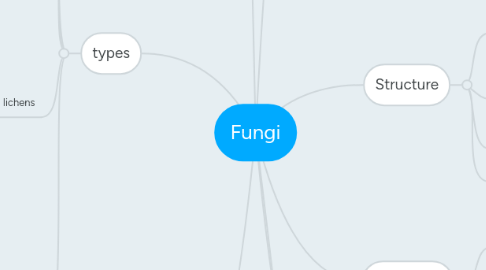
1. other characteristics
1.1. once classified as plants
1.2. cell wall
1.3. grow best in
1.3.1. warm
1.3.2. humid
1.3.3. tropical
1.3.4. in between toes
1.4. can be both large or small
1.4.1. 15 hectares in washington
1.4.2. 600 hectares in Washington
2. reproduction
2.1. two genetically different hyphae conect
2.1.1. meiosis occurs
2.1.1.1. spores form
2.1.1.1.1. waterproof
2.1.1.1.2. reproductive cell
3. types
3.1. club
3.1.1. mushroom
3.1.1.1. basidium
3.2. sac
3.2.1. ascus
3.2.1.1. U.S. Sac (100%)
3.2.2. mostly many celled
3.2.3. yeast
3.2.3.1. single-celled
3.2.3.2. reproduce sexually
3.3. zygote fungi
3.3.1. sporangium
3.3.1.1. spore case
3.3.2. bread
3.4. lichens
3.4.1. made of a fungus and an alga/cyanobacterium
3.4.2. symbiosis
3.4.2.1. cyanobacterium/alga -> home
3.4.2.2. "rent"
3.4.2.3. fungus -> glucose
3.4.3. importance
3.4.3.1. food source
3.4.3.1.1. caribou
3.4.3.1.2. musk oxen
3.4.3.1.3. deer
3.4.3.1.4. various woodland critters
3.4.3.2. erode rocks/form soil
3.4.3.3. monitor pollution levels
3.5. imperfect fungi
3.5.1. no evidence of sexual reproduction
3.5.2. reproduce asexually only
3.5.3. ringworms/athlete's foot
3.5.4. penicillium
3.5.4.1. eliminates competition
4. Importance
4.1. food
4.1.1. foods made using fungi
4.1.1.1. cheese
4.1.1.2. bread (yeasts)
4.2. wild may be poisonous
4.3. agriculture
4.3.1. cause disease in crops
4.3.1.1. Dutch Elm
4.3.1.2. Apple scab
4.3.1.3. ergot disease of rye
4.3.1.4. smuts/rust
4.3.1.4.1. cause billions in crop damage
4.4. Health/Medicine
4.4.1. can cause disease
4.4.1.1. ringworm/athlete
4.4.1.1.1. skin infections
4.4.1.1.2. imperfect bacteria
4.4.1.2. can also cause respiratory infections
4.5. positive effects
4.5.1. some naturally produce antibiotics
4.5.1.1. penicillium->penicillin
4.5.1.1.1. grown commercially
4.5.1.2. cyclosplorine
4.5.1.2.1. fight body's rejection of transplanted organs
4.5.1.2.2. derived from fungi
4.5.2. saprophytes
4.5.2.1. produce soil
4.5.2.2. nature's recyclers
4.6. economic effects
4.6.1. Irish potato famine
4.6.2. almost wiped out French wine
5. What are?
5.1. mushrooms
5.2. yeast
5.2.1. bread
5.3. mold
5.3.1. in bread
5.4. mildew
5.4.1. shower curtains
6. Origin
6.1. fossil record
6.1.1. not too helpful
6.2. maybe algae
6.3. likely
6.3.1. flagellated protists
6.3.2. slime molds
7. Structure
7.1. hyphae
7.1.1. many-celled
7.1.2. thread-like tubes
7.2. produce enzymes
7.2.1. digestion happens on the outside
7.2.1.1. break down
7.2.1.2. fungal cells absorb
7.3. most are many-celled
7.4. most are saprophytic
8. Fungi and Plants
8.1. some fungi interact with plant roots
8.2. form mycorrhizae
8.2.1. 80% of plants develop
8.2.2. symbiosis
8.2.2.1. fungus -> glucose
8.2.2.2. plant -> nutrients
8.2.3. lady's slipper is dependant
8.3. fossilized fungus
8.3.1. 460 million year old rock
8.3.2. forms association w/ plant roots
8.3.3. enabled algae to move onto land

